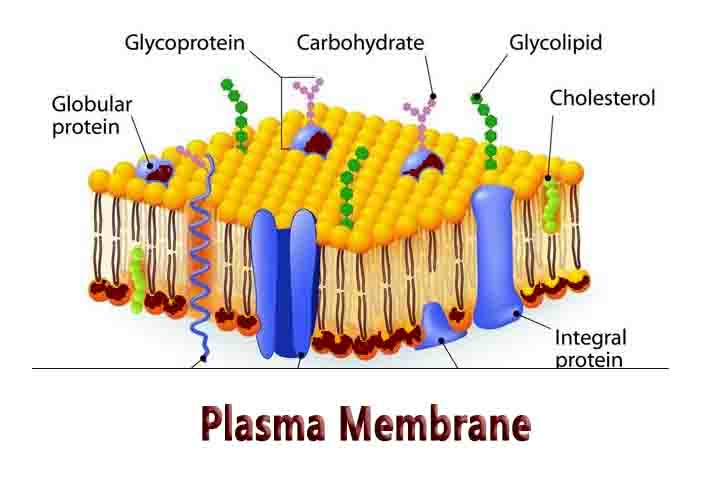Plasma Membrane Definition
The plasma membrane of a cell is a network of lipids and proteins that forms the boundary between a cell’s contents and the outside of the cell. It is also simply called the cell membrane.
The main function of the plasma membrane is to protect the cell from its surrounding environment. It is semi-permeable and regulates the materials that enter and exit the cell. The cells of all living things have plasma membranes.
Functions of the Plasma Membrane
A Physical Barrier
The plasma membrane surrounds all cells and physically separates the cytoplasm, which is the material that makes up the cell, from the extracellular fluid outside the cell. This protects all the components of the cell from the outside environment and allows separate activities to occur inside and outside the cell.
The plasma membrane provides structural support to the cell. It tethers the cytoskeleton, which is a network of protein filaments inside the cell that hold all the parts of the cell in place. This gives the cell its shape. Certain organisms such as plants and fungi have a cell wall in addition to the membrane.
The cell wall is composed of molecules such as cellulose. It provides additional support to the cell, and it is why plant cells do not burst like animal cells do if too much water diffuses into them.
Selective Permeability
Plasma membranes are selectively permeable (or semi-permeable), meaning that only certain molecules can pass through them. Water, oxygen, and carbon dioxide can easily travel through the membrane. Generally, ions (e.g. sodium, potassium) and polar molecules cannot pass through the membrane; they must go through specific channels or pores in the membrane instead of freely diffusing through. This way, the membrane can control the rate at which certain molecules can enter and exit the cell.
Endocytosis and Exocytosis
Endocytosis is when a cell ingests relatively larger contents than the single ions or molecules that pass through channels. Through endocytosis, a cell can take in large quantities of molecules or even whole bacteria from the extracellular fluid. Exocytosis is when the cell releases these materials.
The cell membrane plays an important role in both of these processes. The shape of the membrane itself changes to allow molecules to enter or exit the cell. It also forms vacuoles, small bubbles of membrane that can transport many molecules at once, in order to transport materials to different places in the cell.
Cell Signaling
Another important function of the membrane is to facilitate communication and signaling between cells. It does so through the use of various proteins and carbohydrates in the membrane.
Proteins on the cell “mark” that cell so that other cells can identify it. The membrane also has receptors that allow it to carry out certain tasks when molecules such as hormones bind to those receptors.
Plasma Membrane Structure
Phospholipids
The membrane is partially made up of molecules called phospholipids, which spontaneously arrange themselves into a double layer with hydrophilic (“water loving”) heads on the outside and hydrophobic (“water hating”) tails on the inside. These interactions with water are what allow plasma membranes to form.
Proteins
Proteins are wedged between the lipids that make up the membrane, and these transmembrane proteins allow molecules that couldn’t enter the cell otherwise to pass through by forming channels, pores or gates. In this way, the cell controls the flow of these molecules as they enter and exit.
Proteins in the cell membrane play a role in many other functions, such as cell signaling, cell recognition, and enzyme activity.
Carbohydrates
Carbohydrates are also found in the plasma membrane; specifically, most carbohydrates in the membrane are part of glycoproteins, which are formed when a carbohydrate attaches to a protein. Glycoproteins play a role in the interactions between cells, including cell adhesion, the process by which cells attach to each other.
Fluid Mosaic Model
Technically, the cell membrane is a liquid. At room temperature, it has about the same consistency as vegetable oil.
Lipids, proteins, and carbohydrates in the plasma membrane can diffuse freely throughout the cell membrane; they are essentially floating across its surface. This is known as the fluid mosaic model, which was coined by S.J. Singer and G.L. Nicolson in 1972.
Related Biology Terms
- Cell wall – A structure that surrounds the plasma membrane of plant and fungus cells and provides additional support to those cells.
- Phospholipid – a molecule that forms the characteristic double layer of the plasma membrane.
- Semi-permeable – allowing only certain molecules to pass through due to the chemical properties of the membrane.
- Fluid Mosaic Model – a model that describes the composition of the plasma membrane and how phospholipids, proteins, and carbohydrates freely move within it.

